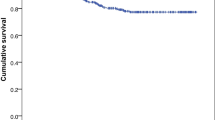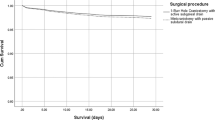Abstract
Introduction
Chronic subdural hematoma (cSDH) is a common condition that causes significant morbidity and mortality. In rural sub-Saharan Africa, there are very few neurosurgeons. Yet, cSDH is treatable by relatively simple surgical intervention with potential for rapid clinical improvement.
Methods
We conducted a retrospective chart review of all patients with cSDH who underwent burr-hole trephination at Tenwek Hospital, Kenya, between July 2014 and July 2016. We extracted and compared the clinical presentation, risk factors, operative details, and outcomes.
Results
A total of 119 patients were identified with a mean age of 61.3 years. The majority were men (80%). The main predisposing factors were trauma (54.6%) and alcohol intake (34.4%). Patients were generally managed with two burr-holes, irrigation, and a subdural drain, remaining for a median of 2 days. Operations were assisted by general surgery residents under direct supervision of senior residents (46), general surgeons (65), and neurosurgeons (8). Complications included recurrence (5.2%), subdural empyema (2.5%), postoperative seizures (3.4%), and mortality (6.7%). Improvement of symptoms was noted in 91% of all patients.
Conclusion
Operative management of cSDH can be safely performed in rural facilities by general surgeons familiar with the procedure and with the institutional resources. The majority of patients had satisfactory outcomes.
Similar content being viewed by others
References
Panourias IG, Skiadas PK, Sakas DE et al (2005) Hippocrates: a pioneer in the treatment of head injuries. Neurosurgery 57:181–189
Margetts EL (1967) Trepanation of the skull by the medicine-men of primitive cultures, with particular reference to present-day native East African practice. In: Brothwell D, Sandison AT (eds) Diseases in antiquity: a survey of diseases, injuries and surgery of early populations. Charles C Thomas, Springfield, pp 637–701
Qureshi MM, Olunya DO (2010) History of neurosurgery in Kenya, East Africa. World Neurosurg 73(4):261–263
Otieno T, Woodfield JC, Bird P et al (2004) Trauma in rural Kenya. Injury 35(12):1228–1233
Albright AL, Ferson SS (2012) Developing pediatric neurosurgery in a developing country. J Child Neurol 27(12):1559–1564
Kolias AG, Chari A, Santarius T et al (2014) Chronic subdural haematoma: modern management and emerging therapies. Nat Rev Neurol 10(10):570–578
Parlato C, Garracino A, Moraci A (2000) Spontaneous resolution of chronic subdural hematoma. Surg Neurol 53(4):312–317
Ethem G, Mahmut A, Tanju U et al (2009) Spontaneous resolution of large chronic subdural hematoma: a case report and review of literature. Turk J Emerg Surg 15(1):95–98
Gökmen M, Sucu HK, Ergin A et al (2008) Randomized comparative study of burr-hole craniostomy versus twist drill craniostomy; surgical management of unilateral hemispheric chronic subdural hematomas. Cent Eur Neurosurg Zentralblatt für Neurochir 69(03):129–133
Liu W, Bakker NA, Groen RJ (2014) Chronic subdural hematoma: a systematic review and meta-analysis of surgical procedures: a systematic review. J Neurosurg 121(3):665–673
Ishibashi A, Yokokura Y, Adachi H (2011) A comparative study of treatments for chronic subdural hematoma: burr hole drainage versus burr hole drainage with irrigation. Kurume Med J 58(1):35–39
Mondorf Y, Abu-Owaimer M, Gaab MR et al (2009) Chronic subdural hematoma—craniotomy versus burr hole trepanation. Br J Neurosurg 23(6):612–616
Treacy PJ, Reilly P, Brophy B (2005) Emergency neurosurgery by general surgeons at a remote major hospital. ANZ J Surg 75(10):852–857
Phang I, Sivakumaran R, Papadopoulus MC (2015) No association between seniority of surgeon and postoperative recurrence of chronic subdural hematoma. Ann R Coll Surg Engl 97(8):584–588
Liang KE, Bernstein I, Yoko KA et al (2016) Enhancing neurosurgical education in low- and middle-income countries: current methods and new advances. Neurol Med Chir 56(11):709–715
Ellegala DB, Simpson L, Mayegga E et al (2014) Neurosurgical capacity building in the developing world through focused training: clinical article. J Neurosurg 121(6):1526–1532
Wilson DA, Garrett MP, Wait SD et al (2012) Expanding neurosurgical care in northwest Tanzania: the early experience of an initiative to teach neurosurgery at bugando medical centre. World Neurosurg 77(1):32–38
Fuller A, Tran T, Muhumuza M et al (2016) Building neurosurgical capacity in low and middle income countries. eNeurologicalSci 3:1–6
Park BE (2010) The African experience: a proposal to address the lack of access to neurosurgery in rural sub-Saharan Africa. World Neurosurg 73(4):276–279
Santarius T, Kirkpatrick PJ, Ganesan D et al (2009) Use of drains versus no drains after burr-hole evacuation of chronic subdural haematoma: a randomised controlled trial. Lancet 374(9695):1067–1073
Peng D, Zhu Y (2016) External drains versus no drains after burr-hole evacuation for the treatment of chronic subdural haematoma in adults. Cochrane Database Syst Rev. Issue 8. Art. No.: CD011402. doi:10.1002/14651858.CD011402.pub2
Kaptigau WM, Rosenfeld JV, Kevau I et al (2016) The establishment and development of neurosurgery services in Papua New Guinea. World J Surg 40(2):251–257. doi:10.1007/s00268-015-3268-1
Park BE (2016) Surgical treatment of degenerative lumbar spine disease in rural sub-Saharan Africa: a retrospective study of 450 cases and its future implications. World Neurosurg 87:417–421
Cheatham ML (2013) Bringing neurosurgical and neurological care to the world. Surg Neurol Int. doi:10.4103/2152-7806.120221
Pollock JD, Love TP, Steffes BC (2011) Is it possible to train surgeons for rural Africa? A report of a successful international program. World J Surg 35(3):493–499. doi:10.1007/s00268-010-0936-z
Mock CN, Donkor P, Gawande A et al (2015) Essential surgery: key messages from disease control priorities. Lancet 385(9983):2209–2219
El Khamlichi A (2001) African neurosurgery: current situation, priorities, and needs. Neurosurgery 48:1344–1347
El-Fiki M (2010) African neurosurgery, the 21st-century challenge. World Neurosurg 73(4):254–258
Schecter WP, Peper E, Tuatoo V (1985) Can general surgery improve the outcome of the head-injury victim in rural America? A review of the experience in American Samoa. Arch Surg 120:1163–1166
Rinker CF, McMurry FG, Groeneweg VR et al (1998) Emergency craniotomy in a rural Level III trauma center. J Trauma 44(6):984–989
Wester K (1999) Decompressive surgery for “pure” epidural hematomas: does neurosurgical expertise improve the outcome? Neurosurgery 44(3):495–500
Bishop CV, Drummond KJ (2006) Rural neurotrauma in Australia: implications for surgical training. ANZ J Surg 76(1–2):53–59
Luck T, Treacy PJ, Mathieson M et al (2015) Emergency neurosurgery in Darwin: still the generalist surgeons’ responsibility. ANZ J Surg 85(9):610–614
Coburger J, Leng LZ, Rubin DG et al (2014) Multi-institutional neurosurgical training initiative at a tertiary referral center in Mwanza, Tanzania: where we are after 2 years. World Neurosurg 82(1):e1–e8
Ellegala DB, Simpson L, Mayegga E et al (2014) Neurosurgical capacity building in the developing world through focused training: clinical article. J Neurosurg 121(6):1526–1532
Ibrahim GM, Bernstein M (2015) Models of neurosurgery international aid and their potential ethical pitfalls. Virtual Mentor 17(1):49
Prinja S, Nandi A, Horton S et al (2015) Costs, effectiveness, and cost-effectiveness of selected surgical procedures and platforms. In: Debas HT, Donkor P, Gawande A, Jamison DT, Kruk ME, Mock CN (eds) Essential surgery: disease control priorities, 3rd edn (vol 1). The International Bank for Reconstruction and Development/The World Bank, Washington; 2015 Apr 2. Chapter 18. PubMed PMID: 26741010
Sambasivan M (1997) An overview of chronic subdural hematoma: experience with 2300 cases. Surg Neurol 47(5):418–422
Mori K, Maeda M (2001) Surgical treatment of chronic subdural hematoma in 500 consecutive cases: clinical characteristics, surgical outcome, complications, and recurrence rate. Neurol Med Chir (Tokyo) 41(8):371–381
Miranda LB, Braxton E, Hobbs J et al (2011) Chronic subdural hematoma in the elderly: not a benign disease. J Neurosurg 114:72–76
Weigel R, Schmiedek P, Krauss JK (2003) Outcome of contemporary surgery for chronic subdural haematoma: evidence based review. J Neurol Neurosurg Psychiatry 74(7):937–943
Horn EM, Feiz-Erfan I, Bristol RE et al (2006) Bedside twist drill craniostomy for chronic subdural hematoma: a comparative study. Surg Neurol 65:150–153
Neils DM, Singanallur PS, Wang H et al (2011) Recurrence-free chronic subdural hematomas: a retrospective analysis of the instillation of tissue plasminogen activator in addition to twist drill or burr hole drainage in the treatment of chronic subdural hematomas. World Neurosurg 78:145–149
Nayil K, Ramzan A, Sajad A et al (2012) Subdural hematomas: an analysis of 1181 Kashmiri patients. World Neurosurg 77:103–110
Tumusiime G, Was A, Preston MA et al (2016) The quality and utility of surgical and anesthetic data at a Ugandan Regional Referral Hospital. World J Surg 41:1–10. doi:10.1007/s00268-016-3714-8
White RE, Parker RK, Fitzwater JW et al (2009) Stents as sole therapy for oesophageal cancer: a prospective analysis of outcomes after placement. Lancet Oncol 10(3):240–246
Ologunde R, Rufai SR (2013) Surgical follow-up in low-income and middle-income countries. Lancet Glob Health 1(3):e132
Author information
Authors and Affiliations
Corresponding author
Ethics declarations
Conflict of interest
The authors declare that they have no conflict of interest.
Rights and permissions
About this article
Cite this article
Kanyi, J.K., Ogada, T.V., Oloo, M.J. et al. Burr-Hole Craniostomy for Chronic Subdural Hematomas by General Surgeons in Rural Kenya. World J Surg 42, 40–45 (2018). https://doi.org/10.1007/s00268-017-4143-z
Published:
Issue Date:
DOI: https://doi.org/10.1007/s00268-017-4143-z




